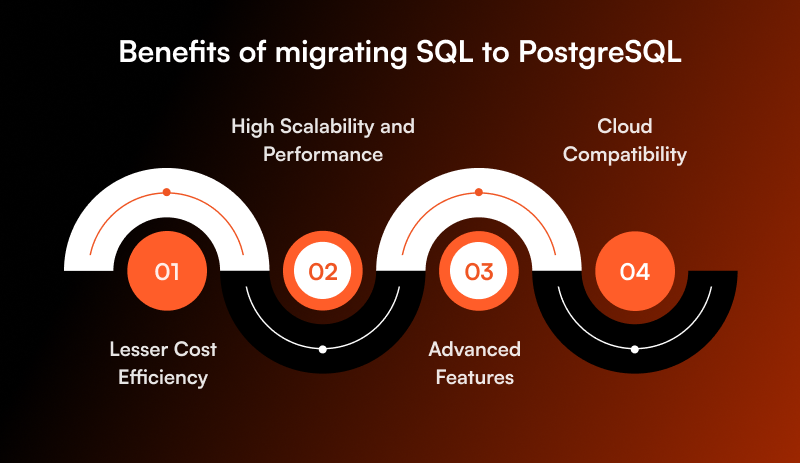
Here’s what you will learn:
Nowadays, businesses are growing their capabilities and are surely dealing with vast amounts of data. To manage these vast sets of data, the need for scalable data management systems is also evolving. These scalable data management systems have several features like enhanced performance, scalability, and flexibility.
Today, many organizations are transferring their datasets from traditional databases, like Microsoft SQL server or Oracle to PostgreSQL. Being an advanced yet open-source relational database, PostgreSQL is well-known for its robustness and versatility. Moreover, considering SQL to PostgreSQL migration to be simple migration of data from single database to another.
However, this migration requires special considerations, careful planning, utilizing the right tools, or expertise to avoid disruptions while maintaining data integrity and high performance.
So, in this article, we’ll explore the following aspects:
- Why does a business require Migration from SQL to PostgreSQL?
- How to Effectively Execute a Seamless Migration Plan?
- What are the Challenges that businesses might face?
Table of Contents
Why is Migration from SQL to PostgreSQL Beneficial?
Being a leading open-source database system, PostgreSQL offers several beneficial features, like reliability and cost-effectiveness. Migrating from a SQL-based database system is a strategic approach. However, it is crucial to understand that businesses might face several challenges without well-defined strategies. Now, it is time to know the reasons why organizations choose to migrate from SQL to PostgreSQL in detail:

1. Cost Efficiency:
SQL Server and Oracle are proprietary systems that deal with expensive licensing models. These licensing models are suitable for businesses requiring high scalability with a large number of users.
However, PostgreSQL is an open-source database that eliminates the concern of licensing fees and provides several cost-effective solutions in the long term. Therefore, by migrating to PostgreSQL, businesses can significantly enjoy several benefits, as follows:
a. Reduced cost of database management
b. Investing resources elsewhere
Open-Source Flexibility: Being open source, PostgreSQL is supported by a large or active community. Additionally, this SQL database can modify the source code with the integration of custom features and avoid vendor lock-in. This further helps businesses to enjoy complete control over the database with its configuration.
2. Scalability and Performance:
PostgreSQL provides high scalability and robust performance while handling large datasets and complex queries. This open-source database is truly a strong contender for businesses willing to scale their database systems due to the following:
a. Support for high-concurrency operations
b. Ability to perform well with big data apps
3. Advanced Features:
PostgreSQL tends to provide several high-tech features that are somehow unavailable in traditional SQLs, i.e., SQL Server or Oracle. Some of these advanced features are as follows:
- JSON and JSONB provide support for storing and querying unstructured data
- Full-Text Search capabilities
- Foreign data wrappers help to integrate external data sources
- Table inheritance helps businesses to organize data in a hierarchical manner.
4. Cloud Compatibility:
Businesses are getting indulged with Cloud technologies and thus, PostgreSQL has become a go-to database for cloud-native applications. With seamless integration to cloud platforms, including AWS, Google Cloud, or Microsoft Azure, it becomes an impressive choice for businesses to migrate their data to the cloud.
How to Ensure a Successful Transition from SQL to PostgreSQL?
Data migration is surely a complex process. Therefore, with careful planning and execution, businesses can enjoy a seamless and secure transition from SQL to PostgreSQL. So, here comes a small outline defining the approach to migrate data to ensure smooth transitions:
1. Assess the Current SQL Database:
Firstly, a business must begin with a detailed assessment of the existing SQL database by performing the following steps:
- Evaluation of database schema: Going through tables, relationships, and constraints within SQL Server or Oracle database to identify how they will map to PostgreSQL.
- Knowing dependencies: Knowing and understanding the dependencies, especially third-party apps, reporting systems, or integrations that have true dependencies current database system
- Assessing performance requirements: Identifying the performance requirements for your PostgreSQL database. This is somehow crucial for complex queries or high-volume operations.
2. Plan the Migration Strategy:
With proper planning or migration strategies, businesses can ensure a successful SQL to PostgreSQL migration. So, here are some essential aspects that business must consider while planning a strategy:
- Migration Scope: Identifying what all parts of the database, apps, and workloads must be migrated.
- Data Migration Methods: Choose the migration method, like ETL or real-time replication.
- Timeline: Design a realistic timeline for every phase associated with the migration process with minimal business downtime or disruption.
- Backup Strategy: The Business must ensure that they have full backups of the SQL database to prevent data loss during migration. Remember to prepare backups before beginning the migration process.
3. Prepare the PostgreSQL Environment:
Now, businesses may initiate setting up their PostgreSQL environment once the migration strategies have been planned. To do so, follow the steps below:
- Install PostgreSQL: Set up the PostgreSQL database on your server or cloud platform. Moreover, businesses must ensure that they’ve installed the right version or PostgreSQL keeping their requirements as focused.
- Create Database Schemas: Businesses need to define the tables, relationships, indexes, or foreign keys properly by recreating the database schema in PostgreSQL.
- Install Necessary Extensions: PostgreSQL surely supports different extensions, like PostGIS or pg_stat_statements. Thus, businesses need to install these extensions once they are needed for smooth transition.
4. Migrate the Data
Data migration is the major step related to any migration process. Thus, businesses require some tools or methods to ensure the quick migration of data from SQL to PostgreSQL. Let’s walk through these tools or methods in detail:
- pgLoader: This is an open-source tool helping businesses to automate the data migration process from SQL to PostgreSQL. Moreover, this tool helps businesses to convert their SQL server schema and migrate data to PostgreSQL efficiently.
- AWS Database Migration Service (DMS): Designed by AWS, this tool supports SQL to PostgreSQL migration for large-scale environments with minimal downtime (during transition).
- Custom Scripts: Once automated tools are not functionally fulfilling the business goals, custom scripts can significantly help. Custom scripts are written to extract data from SQL Server or Oracle and further load to PostgreSQL. These have a tendency of handling data types, schema differences, and transformations.
5. Migrate Stored Procedures, Functions, and Triggers:
By utilizing PL/pgSQL as a procedural language in PostgreSQL, businesses can rewrite stored procedures, triggers, or functions. However, SQL Server utilizes T-SQL or Oracle uses PL/SQL. Moreover, depending upon the complexity of the existing database logic, this can be somehow time-consuming. With tools like pgAdmin, businesses can manage and test the procedures in PostgreSQL.
6. Validate and Test the Migration:
Validating and testing the integrity of data and the functioning of the application is highly crucial once the migration process is completed. To do so, perform the following steps:
- Data Validation: Ensure that all data has been transferred properly with no data loss or corruption.
- Performance Testing: Executing performance testing can ensure that PostgreSQL database functions speedily and efficiently. Therefore, comparing query performance between SQL Server or Oracle and PostgreSQL will help to ensure that new systems fulfill performance expectations.
- Application Testing: Application testing can ensure that applications with strong reliance over database are functioning properly with PostgreSQL systems. This test may involve verification of several application features, like reporting, user interfaces, and integrations to function wisely.
7. Cut Over to PostgreSQL:
On completing the testing procedures and issues are resolved, here comes the time to switch to production systems to new PostgreSQL database. This includes the following steps:
- Switching Connections: Update all apps, services, or integrations to point to the new PostgreSQL database
- Monitoring: Businesses can identify possible issues and ensure optimal performance of database with continuous monitoring of the PostgreSQL environment.
What are the Challenges in SQL to PostgreSQL Migration?
There are several benefits associated with migration of data from SQL to PostgreSQL. However, there are some significant challenges that may arise during the process:
a. Data Type Compatibility: SQL Server and PostgreSQL supports different data types. Thus, business must map data types carefully to ensure data consistency.
b. Stored Procedures or Functions: Migration of stored procedures and functions can be complex. Thus, businesses need to redefine or rewrite logic from T-SQL to PL/pgSQL.
c. Indexing and Performance Optimization: Working on different indexing techniques, PostgreSQL queries or indexes must be optimized after migration to attain the best performance.
d. Downtime: Keeping the size of the migration, downtime might be possible. By utilizing tools, like AWS DMS, business can minimize downtime by offering support to ongoing replication.
How Can Data Migration Services Assist?
Migrating from SQL Server or Oracle to PostgreSQL can be a complex and challenging task. Moreover, the process can be time-consuming too. Here, data migration services play a crucial role to ease the process by providing expert guidance, specialized tools, or experience to manage large-scale migrations. So, let’s walk through the aspects of how data migration services can help:
- Expertise: Utilizing their in-depth knowledge of SQL Server, Oracle, or PostgreSQL, migration service providers can assist with complex issues that might arise during migration process. This may include data type mapping, compatibility, and stored procedure translation.
- Automation: Several automation tools or scripts can help to speed up the migration process while reducing human errors. This further ensures efficient or accurate transferring of data.
- Support: With professional migration services, businesses can attain post-migration support to assist or troubleshoot the issues being faced. This leads to ensure that PostgreSQL environment is executing smoothly.
Working with an experienced or reliable Oracle-certified partner, business can enhance their migration process. These certified partners offer expert-level support related to Oracle databases to ensure seamless SQL to PostgreSQL migration with minimized risk or downtime.
The Final Words:
Undoubtedly! Data Migration from SQL Server or Oracle to PostgreSQL provides businesses with cost-effective, scalable, or high-performance solutions for modern data management. Being a complex process, data migration requires proper planning with expertise and the right tools to ensure a successful transition to PostgreSQL with minimal disruptions.
Moreover, with reliable data migration services, businesses can enjoy an efficient and secure migration process with minimized downtime and data integrity issues. Additionally, Oracle certified partners can further ensure that migration process are handled professionally with best possible practices and industry standards.

